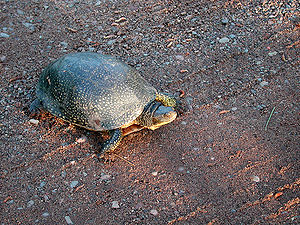American pond turtle
| American pond turtle | ||||||||||||
|---|---|---|---|---|---|---|---|---|---|---|---|---|

American pond turtle |
||||||||||||
| Systematics | ||||||||||||
|
||||||||||||
| Scientific name of the genus | ||||||||||||
| Emydoidea | ||||||||||||
| JE Gray , 1870 | ||||||||||||
| Scientific name of the species | ||||||||||||
| Emydoidea blandingii | ||||||||||||
| ( Holbrook , 1838) |
The American pond turtle ( Emydoidea blandingii ) is a monogeneric species from the New World pond turtle family . Its distribution area is North America and extends from Canada, where it occurs on the Great Lakes and in Nova Scotia, to Nebraska and the southeast of the US state New York. Their existence is considered threatened.
Appearance
The American pond turtle is a medium-sized species of tortoise. It has a carapace length that ranges from 12.5 to a maximum of 26.8 centimeters. The back armor is blue-black and has yellowish spots and spots, especially on the edge shields. The belly armor is yellowish and is marked with large black spots. In some individuals, this pattern of spots is so dense that the yellowish basic color of the belly can no longer be recognized.
A striking characteristic of the American pond turtle is the striking yellow chin and throat drawing. The head and legs are dark and usually also have yellowish spots.
The closest relatives of this species are the Pacific pond turtle ( Actinemys marmorata ) and the European pond turtle of the genus Emys .
Reproduction
American pond turtles usually only become reproductive when they are between 14 and 20 years old. The main mating season falls in April to May; Depending on the location, individuals mate as early as March or the mating is delayed until November. The clutch size varies. In New York State, clutches typically have five to 12 eggs.
Way of life and habitat
The American pond turtle lives in shallow waters with rich vegetation and a soft subsoil. She is an agile, good swimmer. It is not as tied to water as some other New World pond turtles and frequently migrates on land. It is a very shy species of turtle that plunges into the water when disturbed and then stays on the ground for hours. If it is caught out of the water, it retreats into its shell.
The American pond turtle overwinters in or near water, where it burrows in mud or under vegetation. It prefers to eat small crustaceans, but also worms, insect larvae, frogs and carrion and also eats plant-based food. It is fast enough to eat live fish. It can reach an age of up to 70 years.
Duration
The population declines of the American pond turtle result mainly from the destruction and fragmentation of their habitat. It is on the Endangered Species List in the US states of Illinois, Iowa, Massachusetts, Minnesota, New York, Main, South Dakota, Missouri and Wisconsin, as well as in the Canadian provinces of Ontario, Nova Scotia and Quebec.
proof
Individual evidence
- ↑ Archive link ( Memento of the original from January 14, 2009 in the Internet Archive ) Info: The archive link was inserted automatically and has not yet been checked. Please check the original and archive link according to the instructions and then remove this notice.
- ↑ Rogner gives 3 to 18 eggs as clutch size, see Sect. P. 61.
literature
- Manfred Rogner: Tortoises - biology, keeping, reproduction. Eugen Ulmer KG, Stuttgart 2008, ISBN 978-3-8001-5440-1 .
Web links
- Blanding's Turtle Fact Sheet
- Michigan Dept. of Natural Resources Blanding's Turtle (Emys blandingii)
- Blanding's Turtle - Emydoidea blandingii Species account from the Iowa Reptile and Amphibian Field Guide
- Emydoidea blandingii inthe IUCN 2013 Red List of Threatened Species . Posted by: van Dijk, PP & Rhodin, AGJ, 2010. Retrieved September 25, 2013.
- Emydoidea blandingii in The Reptile Database